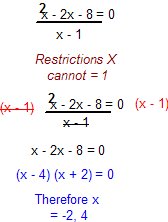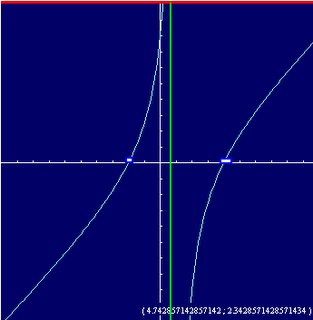In the last few days we've been looking at radical equations, and when solving these equations (roots) we sometimes get extraneous roots. Well, this class was about: Why do we get these roots in rational equation.
LETS LOOK AT THESE Qs


This means: the graph can't touch 1 and has roots when x=-2 and 4
i.e.
Graphically this is what is going on
 The green line is called the ASYMPTOTE. Its a line that goes as close as possible to the restricted value (in this case 1) but never touches it. Therefore you can have an output when x=0.999 or x=1.111 but not when x=1
The green line is called the ASYMPTOTE. Its a line that goes as close as possible to the restricted value (in this case 1) but never touches it. Therefore you can have an output when x=0.999 or x=1.111 but not when x=1

 In our case here, lets first see the sign changes in the intervals between -infinite to -2; -2 to 1; 1 to 4; and 4 to infinite, in order for us to determine when the equation < style="text-align: center;">
In our case here, lets first see the sign changes in the intervals between -infinite to -2; -2 to 1; 1 to 4; and 4 to infinite, in order for us to determine when the equation < style="text-align: center;">
1st interval -ve infinite to -2
pick any number in the interval e.g -12
plug into the formula

i.e.

Graphically this is what is going on
 The green line is called the ASYMPTOTE. Its a line that goes as close as possible to the restricted value (in this case 1) but never touches it. Therefore you can have an output when x=0.999 or x=1.111 but not when x=1
The green line is called the ASYMPTOTE. Its a line that goes as close as possible to the restricted value (in this case 1) but never touches it. Therefore you can have an output when x=0.999 or x=1.111 but not when x=1HOW ABOUT IF WE WANT

 In our case here, lets first see the sign changes in the intervals between -infinite to -2; -2 to 1; 1 to 4; and 4 to infinite, in order for us to determine when the equation < style="text-align: center;">
In our case here, lets first see the sign changes in the intervals between -infinite to -2; -2 to 1; 1 to 4; and 4 to infinite, in order for us to determine when the equation < style="text-align: center;">1st interval -ve infinite to -2
pick any number in the interval e.g -12
plug into the formula




Nice pictures Natnael
ReplyDeletegood job on scribing. I understand it a bit more now. :)
ReplyDeleteClear and easy to understand. a good use of colour and images. Thanks for scribing.
ReplyDeleteMr. H
SargentPark School